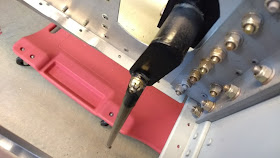Finished all the minor touch up under the inner wings, mounted the landing gear and turned the fuselage back to finish the electrics and engine stuff (the rest actually). Also removed the wind shield (thanks to AirWards kits).
Started to finish the hydraulic brake lines, and then I remembered something from earlier. The brakes are upside down in the drawings.
The break bleeder is on the lowest point. Unless someone have found up a gravity defying device, the only way to bleed the brakes is to put the aircraft upside down. Obviously the brake should be turned 180 degrees.
This is the wrong way:
But this is the right way:
This will also make the bleeder to be on the very top, as it should. The problem now is the brake lines are too short, and I need to get some new ones. I don't like the brass fittings either, brass screwed directly into the aluminium pads. It won't take long before corrosion occur here. I am actually contemplating getting some real Beringer wheels and breaks that are made to last, but I have to try these first and see how well they last.
Started to finish the hydraulic brake lines, and then I remembered something from earlier. The brakes are upside down in the drawings.
The break bleeder is on the lowest point. Unless someone have found up a gravity defying device, the only way to bleed the brakes is to put the aircraft upside down. Obviously the brake should be turned 180 degrees.
This is the wrong way:
But this is the right way:
This will also make the bleeder to be on the very top, as it should. The problem now is the brake lines are too short, and I need to get some new ones. I don't like the brass fittings either, brass screwed directly into the aluminium pads. It won't take long before corrosion occur here. I am actually contemplating getting some real Beringer wheels and breaks that are made to last, but I have to try these first and see how well they last.




















